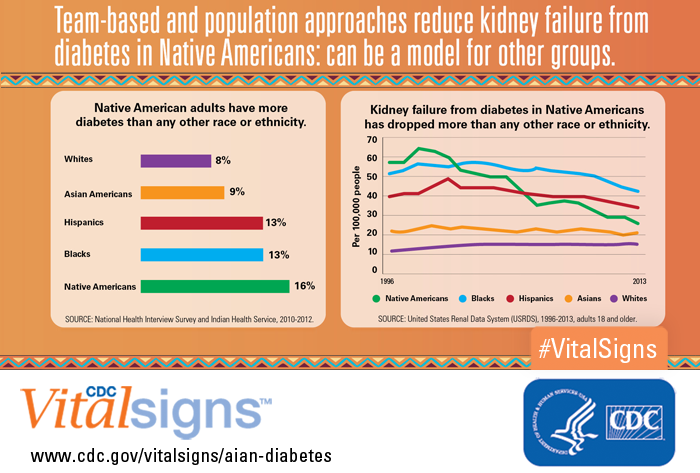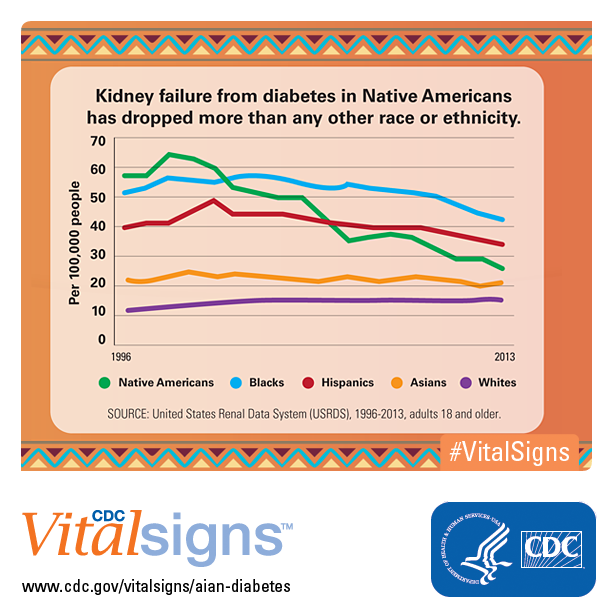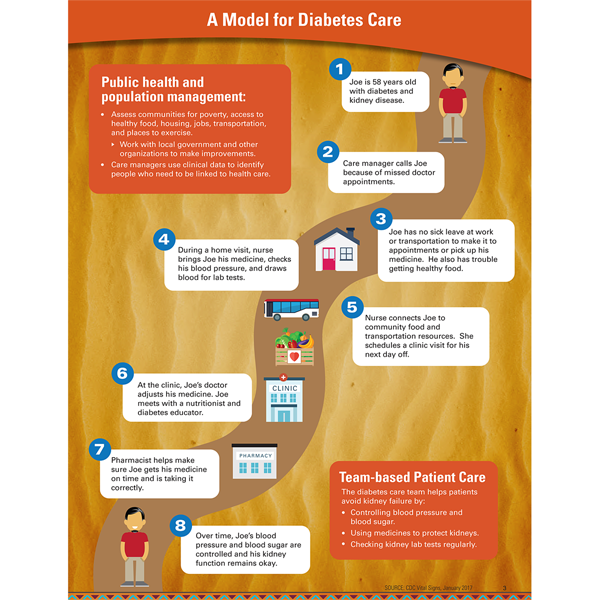Native Americans with diabetes
Kidney disease in Native Americans with diabetes
Remarkable progress made reducing kidney failure from diabetes in Native American populations
Federal data show diabetes-related kidney failure among Native American adults (American Indians/Alaskan Natives) decreased 54 percent between 1996 and 2013. This remarkable decrease follows population-based approaches to diabetes management and improvements in clinical care begun by the Indian Health Service (IHS) in the mid-1980s.
- Native Americans have a greater chance of having diabetes than any other U.S. racial/ethnic group.
- Diabetes is the leading cause of kidney failure in the U.S. Two out of three Native Americans with kidney failure have diabetes. But the rate of diabetes-related kidney failure in Native Americans has declined the fastest of any racial/ethnic group in the U.S.
- Kidney failure is a devastating and costly condition that requires regular dialysis or a kidney transplant for survival. Diabetes-related kidney failure is delayed or prevented by controlling blood pressure and blood sugar, using kidney-protective medicines, and regular kidney testing.
Key Findings from the report include:
- Despite well-documented health and socioeconomic disparities in the Native American population, kidney failure from diabetes has decreased substantially since 1996.
- IHS-supported care for Native Americans with diabetes has improved:
- Use of medicine to protect kidneys increased greatly, from 42% to 74% in 5 years.
- Average blood pressure in those with hypertension is well-controlled (133/76 in 2015).
- Blood sugar control improved by 10% between 1996 and 2014.
- More than 60% of Native Americans 65 years and older had a urine test for kidney damage (2015) compared to 40% of the Medicare diabetes population (2013).
-
The Indian Health Service applied strong coordinated clinical care and education, community outreach and environmental changes. These measure can make a dramatic difference in reducing complications from diabetes for all Americans.
Contact Information
CDC Media Relations
(404) 639-3286
media@cdc.gov
Vital Signs Links
Factsheet:
English [4.01MB]
Spanish [4.03MB]
Spokespersons
Mary L. Smith
“The 54% decline in kidney failure from diabetes followed implementation of public health and population approaches to diabetes as well as improvements in clinical care by the IHS. We believe these strategies can be effective in any population. The patient, family, and community are all key partners in managing chronic diseases, including diabetes.”
Mary L. Smith – Indian Health Service Principal Deputy Director
Ann Bullock, MD

“Reducing complications from diabetes, such as kidney failure, requires years of partnership between patients and their diabetes care team. Health care systems need to take the long view on the costs of providing comprehensive diabetes care versus the benefits of reducing expensive and disabling complications.”
Ann Bullock, M.D. – Director of the Indian Health Service’s Division of Diabetes Treatment and Prevention
Related Links
Most Relevant
- Press Release: Remarkable progress made reducing kidney failure from diabetes in Native American populations – English | Spanish
- MMWR – Vital Signs: Decrease in Incidence of Diabetes-Related End-Stage Renal Disease among American Indians/Alaska Natives — United States, 1996–2013
- Vital Signs: Home | January 2017 Vital Signs | Fact Sheet PDF 4.01 MB | Topics
- Vital Signs: (Spanish) Home | 2017 Enero – Signos Vitales | Fact Sheet PDF 4.03MB | Topics
Additional Resources
- American Association of Kidney Patients
- National Kidney Foundation
- Indian Health Service Homepage
- Division of Diabetes Treatment and Prevention
- Special Diabetes Program for Indians
- NIH National Institute of Diabetes and Digestive and Kidney Diseases
- National Kidney Disease Education Program
- NIH National Diabetes Education Program
- CMS’ Mapping Medicare Disparities tool
- American Diabetes Association
- ADA’s new 2017 Standards of Care
Multimedia
Podcast
- Vital Signs – Native Americans with Diabetes – English | Spanish
- Vital Signs – Native Americans with Diabetes – [PSA – 0:60 seconds]
- Page last reviewed: January 10, 2017
- Page last updated: January 10, 2017
- Content source:



 ShareCompartir
ShareCompartir










